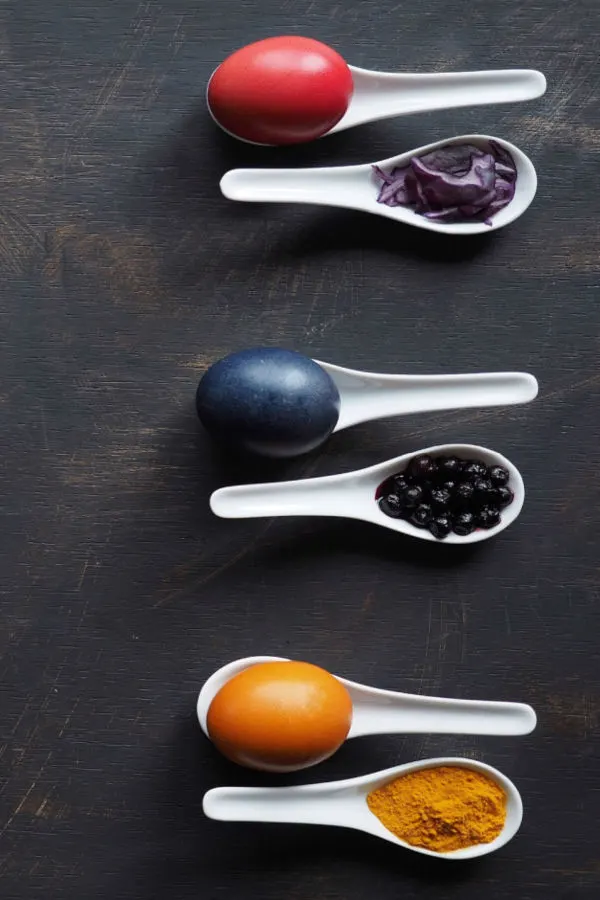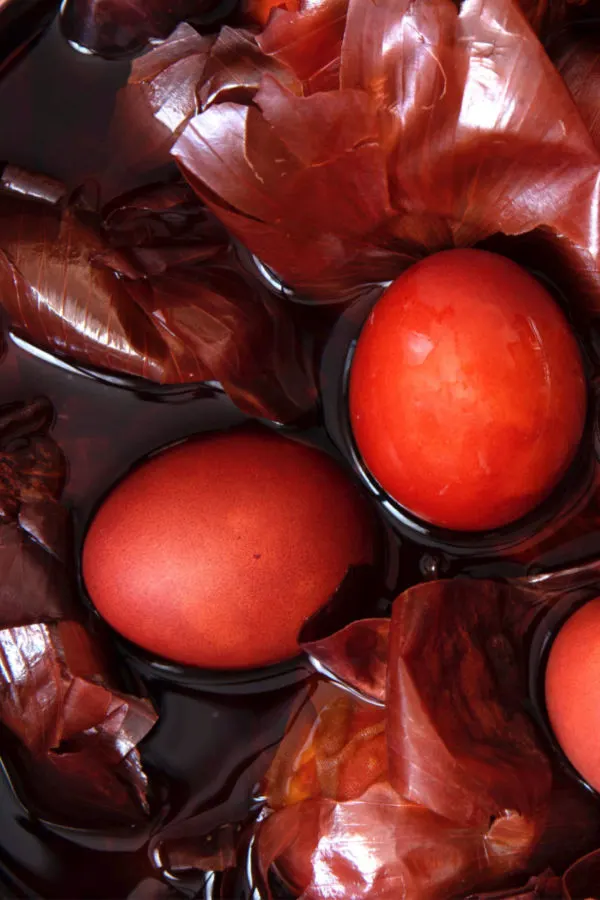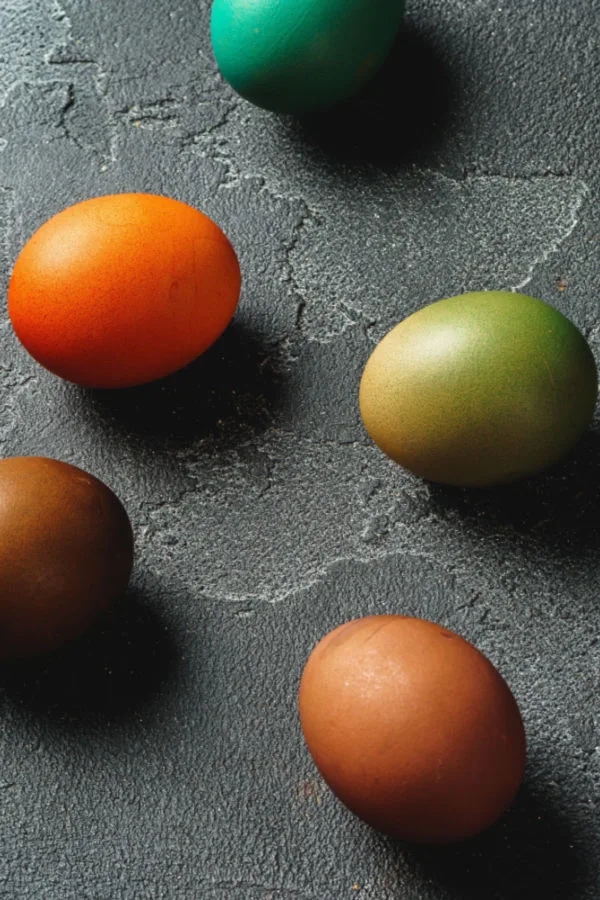Every year around Easter we get several questions about how to color Easter eggs naturally. It is actually very easy to do with a few basic ingredients that you most likely already have in the house.
However, you may be wondering why you would want to do this when you can easily run to the store and buy the pellets that you can soak in water and vinegar. Or why not use the food coloring bottles that you have in your pantry to dye the eggs?
Although both are quick and convenient methods for coloring eggs, many of the artificial dyes contain various chemicals and are commonly derived from petroleum products. So instead of risking the chance that these chemical soak through the outer shell and onto the egg themselves, it is better to dye them with natural ingredients instead.
Luckily coloring your eggs with natural ingredients is much easier than you think. Yes, it may take longer, but it is a great way to to use many of the products that you use will already be in your cabinet, pantry or freezer!
Although, you will still need to add apple cider or white distilled vinegar to get those bright, vibrant colors that you are looking for.
Why Do You Need To Add Vinegar To Color Easter Eggs
Vinegar is used in the process of dyeing eggs because it creates an acidic solution that helps the color bond with the eggshell. In addition the vinegar also helps to brighten the color and make it more vibrant.
This is because the acid in the vinegar helps to break down the outer layer of the eggshell. Because the shells are made out of calcium carbonate, this calcium in the shell reacts with the acid making it easy for the dye to penetrate deeper into the shell making a more intense color.
If you don’t add vinegar to the water, the eggs will still obtain color. However the shells will be lighter and have more of pastel hue. Depending on the natural products that you use to color the eggs and the desired end result, you may or may not need to add vinegar.
Therefore, the list of coloring options below may or may not include vinegar. However, you can always add it if you wish.
Helpful Tips For Dyeing Eggs
1. Use room temperature eggs: Room temperature hard boiled eggs will help the dye adhere more evenly to the eggshell. If you are using farm fresh eggs that are less than a week old, be sure to use this method on How To Boil Eggs.
2. Use apple cider or white distilled vinegar: For brightest colors add about 1 tablespoon of white vinegar to the water. This will help the dye adhere better to the eggshell.
3. Use hot water: It is best to use hot, but not boiling water to color Easter eggs naturally. The heat of the water will allow the dye to penetrate through the egg shell better than if using cold water.
4. Let them soak until the desired colored is reached: Because we are using natural coloring methods the eggs may need to soak longer than if you used a dye packet.
However, to keep the eggs safe do not let them sit out at room temperature for more than 2 hours. Instead, place the jars in the refrigerator and allow them to continue to soak.
4. Let the eggs dry completely: After you’ve finished dyeing your eggs, place them on a wire rack over a baking sheet and let them dry completely before handling them.
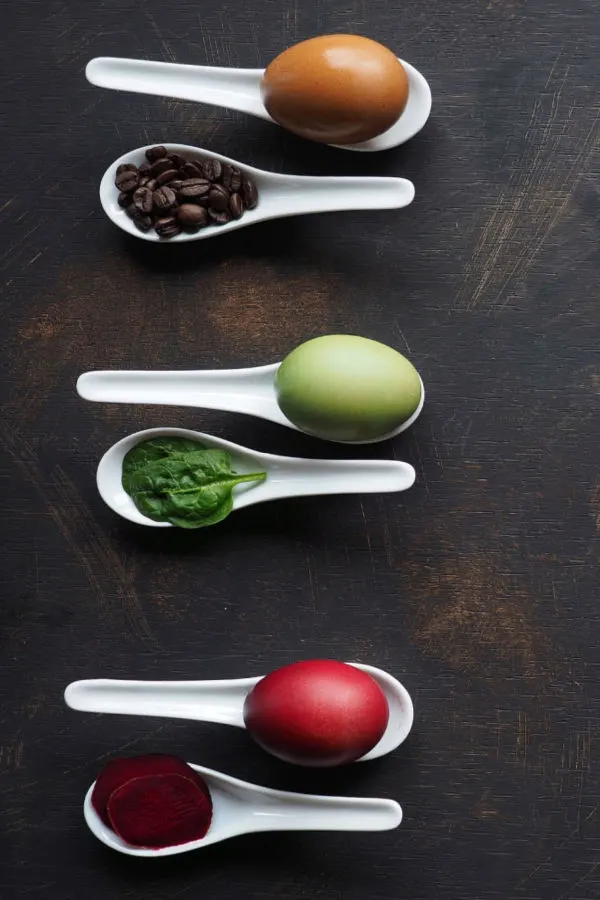
How to Color Easter Eggs Naturally
Below I have listed various ways to dye eggs using natural ingredients. They are listed by the color that the eggs will turn after they have soaked in the dye mixture.
The length of time that the eggs will need to soak will depend on the color that you desire. For the most vibrant colors let the eggs soak overnight in the dye in the refrigerator.
1. Bluish-Gray
Place 1 cup of frozen blueberries in 1 cup of hot water. Allow the mixture to cool to room temperature, then remove the blueberries.
2. Blue
Cut 1/4 head of red cabbage into chunks and place them in a heat proof bowl. Pour 4 cups of boiling water into the bowl and then stir in 2 Tbsp. vinegar. Let the mixture cool to room temperature and strain.
3. Green
Place 2 cups of spinach in a large bowl. Then pour 4 cups of boiling water into the bowl and then stir in 1 Tbsp. vinegar. Let the mixture cool and then strain.
4. Burgundy
One of favorite ways to color Easter eggs naturally is to use the skins from red onions. Start by peeling the outer flaky skins from 6 red onions.
Then place the skins in a sauce pan and pour 2 cups water over the skins. Bring the mixture to a simmer and let it simmer for 15 minutes. Then strain the liquid and add 1 Tbsp. white vinegar and stir.
5. Orange
Use the same procedure that you did with the red onions with yellow onions to naturally turn the Easter Eggs orange. Take the skin of 6 yellow onions and simmer in 2 cups water for 15 minutes and then strain. Stir in 1 Tbsp. white vinegar before dyeing the eggs.
6. Light Red-Orange
Bring 1 cup of water to a boil. Then stir 2 tablespoons paprika until it dissolves. Then add 2 teaspoons of white vinegar to the mixture.
7. Pink
To color Easter eggs pink you will need 6 medium beets, 4 cups water and 1 tablespoon white vinegar. Begin by adding the water to the saucepan and bringing it to a boil.
While the water is heating, peel and chop the beets into chunks. When the water is boiling, add the beets and the vinegar and simmer for 25-30 minutes.
Remove the beets with a slotted spoon (or pour through a strainer), leaving just the dyed water.
8. Yellow
Mustard-yellow: Stir 2 Tbsp. turmeric into 1 cup boiling water then stir in 2 teaspoons white vinegar.
Various shades: Steep 4 bags of chamomile or green tea in 1 cup boiling water for 5 minutes. Then stir in 2 teaspoons vinegar.
Light yellow: Simmer the peels of 6 oranges in 1-1/2 cups water for 20 minutes; strain. Add 2 teaspoons vinegar.
9. Brown-Gold
Simmer 2 Tablespoons of dill seed in 1 cup water for 15 minutes and strain. Then add 2 teaspoons of white vinegar and stir.
10. Brown
Use your leftover coffee to naturally color Easter eggs brown. Do this by adding 1 tablespoon vinegar to 1 cup of strong dark coffee.
Enjoy!
Mary and Jim

Jim and Mary Competti have been writing gardening, DIY and recipe articles and books for over 15 years from their 46 acre Ohio farm. The two are frequent speakers on all things gardening and love to travel in their spare time.
As always, feel free to email us at thefarm@owgarden.com with comments, questions, or to simply say hello! You can sign up for our free email list in the subscribe now box in the middle of this article. Follow us on Facebook here : OWG Facebook. This article may contain affiliate links.
Colored Easter Eggs - Naturally!
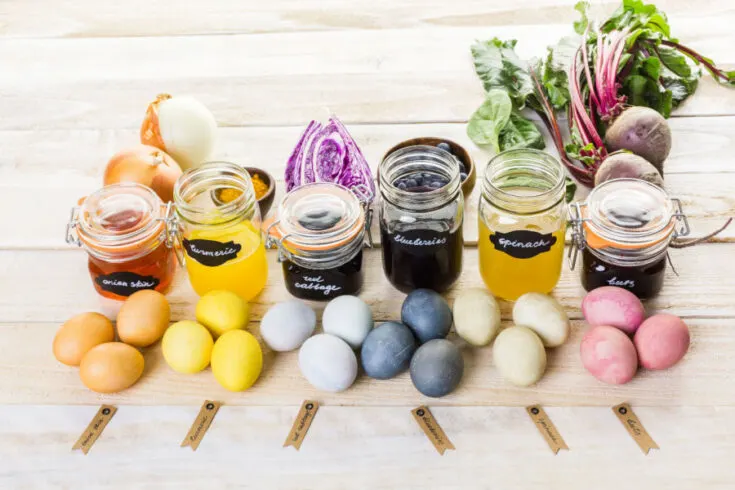
Use these all natural methods for coloring Easter eggs naturally.
Ingredients
- varies - see instructions below
Instructions
Bluish-Gray
- Mix 1 cup frozen blueberries with 1 cup water, bring to room temperature, and remove blueberries.
Blue
- Cut 1/4 head of red cabbage into chunks and add to 4 cups boiling water. Stir in 2 Tbsp. vinegar. Let cool to room temperature and strain.
Green
- Place 2 cups of spinach leaves in a large bowl. Pour 4 cups of boiling water over the leaves and stir in 1 Tbsp. vinegar. Cool to room temperature and strain.
Burnt Orange
- Peel the skin from 6 red onions and simmer in 2 cups water for 15 minutes; strain. Add 1 Tbsp. white vinegar.
Pink
- 6 medium beets– 4 cups water– 1 tablespoon white vinegar (extra to deepen color)
- Begin by adding the water to the saucepan and bringing it to a boil. While the water is heating, peel and chop the beets into chunks. When the water is boiling, add the beets and the vinegar and simmer for 25-30 minutes. Remove the beets with a slotted spoon (or pour through a strainer), leaving just the dyed water.
Orange
- Take the skin of 6 yellow onions and simmer in 2 cups water for 15 minutes; strain. Add 1 Tbsp. white vinegar.
Light Red-Orange
- Stir 2 Tbsp. paprika into 1 cup boiling water; add 2 tsp. white vinegar.
Yellow
- Mustard-yellow Stir 2 Tbsp. turmeric into 1 cup boiling water; add 2 tsp. white vinegar.
- Various shades Steep 4 bags of chamomile or green tea in 1 cup boiling water for 5 minutes. Add 2 tsp. vinegar.
- Light yellow Simmer the peels of 6 oranges in 1-1/2 cups water for 20 minutes; strain. Add 2 tsp. vinegar.
Brown-Gold
- Simmer 2 Tbsp. dill seed in 1 cup water for 15 minutes; strain. Add 2 tsp. white vinegar.
Brown
- Add 1 tablespoon vinegar to 1 cup strong coffee.
Notes
**Use room temperature hard boiled eggs for best results. For the most vibrant colors, keep eggs in dye overnight in the refrigerator.
Recipe courtesy of Old World Garden Farms
Nutrition Information:
Amount Per Serving: Unsaturated Fat: 0g


